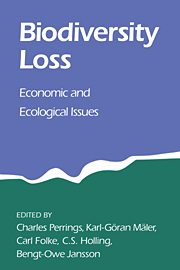Book contents
- Frontmatter
- Contents
- Foreword
- Preface
- List of contributors
- Introduction: framing the problem of biodiversity loss
- PART I CONCEPTUALISING DIVERSITY AND ECOSYSTEM FUNCTIONS
- PART II INTEGRATING ECOLOGY AND ECONOMICS IN THE ANALYSIS OF BIODIVERSITY LOSS
- 4 Wetland valuation: three case studies
- 5 An ecological economy: notes on harvest and growth
- 6 Biodiversity loss and the economics of discontinuous change in semiarid rangelands
- PART III ECONOMIC ISSUES
- PART IV CONCLUSIONS
- References
- Index
5 - An ecological economy: notes on harvest and growth
Published online by Cambridge University Press: 05 June 2012
- Frontmatter
- Contents
- Foreword
- Preface
- List of contributors
- Introduction: framing the problem of biodiversity loss
- PART I CONCEPTUALISING DIVERSITY AND ECOSYSTEM FUNCTIONS
- PART II INTEGRATING ECOLOGY AND ECONOMICS IN THE ANALYSIS OF BIODIVERSITY LOSS
- 4 Wetland valuation: three case studies
- 5 An ecological economy: notes on harvest and growth
- 6 Biodiversity loss and the economics of discontinuous change in semiarid rangelands
- PART III ECONOMIC ISSUES
- PART IV CONCLUSIONS
- References
- Index
Summary
Introduction
These notes offer an interdisciplinary contribution to economics and ecology. The focus is on the coexistence of economic and ecological prosperity. We discuss two topics. We show how best to harvest a resource such as a marine fishery based on a contemporary metapopulation model from ecology, and we also offer a replacement for the neoclassical model of economics that shows how an economy depends on the aggregate of its natural resources, the human population size, and the investment policy. The work on these two topics has been carried out in part simply to see how ecological and economic theory may be combined. The theme of biodiversity is also involved, however, because it emerges that the optimal harvest of a fishery with a pelagic larval phase depends on the biological diversity, not of species, but of habitats in which the adults live. Also, in the macroeconomic realm, work on the second topic shows a dependence of economic prosperity on the stock of natural resources, and implies the need to conserve natural resources from extinction if economic prosperity is to be attained. From an ecological perspective, policies for the development of natural resources should rest on the more realistic models of population dynamics that have emerged in recent years from ecological research, rather than on early ecological textbook models such as the logistic equation. An equation such as the logistic remains valuable when working through practice exercises, just as myths like ideal pulleys and gases remain valuable in teaching mechanics and chemistry.
- Type
- Chapter
- Information
- Biodiversity LossEconomic and Ecological Issues, pp. 150 - 189Publisher: Cambridge University PressPrint publication year: 1995
- 2
- Cited by

